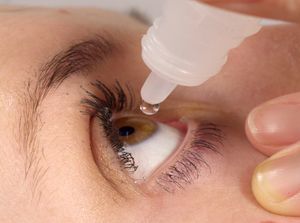Dry Eye
Dry eye is a condition that results from the inability of the tears to sufficiently lubricate the eye. This can be a quantitative deficiency, where the eye does not produce enough tears, or a qualitative problem, where the tear does not contain adequate lubricating and protecting factors.
Symptoms
Tears are produced by two distinctly different methods. One produces a slow, continuous rate of tear formation that is responsible for normal eye lubrication. The other method produces a large burst of tears in response to irritation or emotion. If the slow steady tears do not adequately lubricate the eye, it can become irritated and trigger the burst or “reflex” tear production. It is this situation that is responsible for the “tearing” seen in people with dry eyes (“How can I have dry eyes if I am tearing all the time?”). Other symptoms include stinging or burning, foreign body sensation, the feeling of sand or grit in the eyes, stringy mucous around the eyes, scratchiness, difficulty with contact lenses, and, of course tearing.
Causes of dry eye
Dry eye is often part of the normal aging changes of the body. However, it can be exacerbated or accentuated by sun, wind, cold, indoor heaters or air conditioners, computer screens, reading, high altitude, or recent eye surgery. Certain health conditions and medications can also contribute to dry eye. These include sjogrens syndrome, diabetes, post-menopause, rheumatoid arthritis, asthma, pregnancy, and thyroid disease. Medications include antihistamines, diuretics (water pills), antidepressants, hormone replacement therapy, blood pressure medications, decongestants, and oral contraceptives.
Treatment
Although there is no cure for dry eye, it can be effectively treated in most cases. Altering any environmental factors that contribute to dry eye, such as avoiding smoke, cold or dry rooms, and prolonged computer use, can give symptomatic improvement. However, it is often necessary to add topical lubricants, such as artificial tears, to get significant relief of symptoms. Artificial tears come in various compositions and densities, and some trial and error may be needed to find the most beneficial type, but once found this is usually all the treatment that is needed. Severe dry eye, however, may require the use of topical steroids, ointments, cyclosporin, or placement of punctual plugs. The plugs decrease the loss of the slow steady tears and can markedly improve the dry eye state.
Dry eye is a common but potentially serious ocular disease. There are, however, simple and effective treatment options available. Your eye care professional can help you find the best treatment choice for you.

